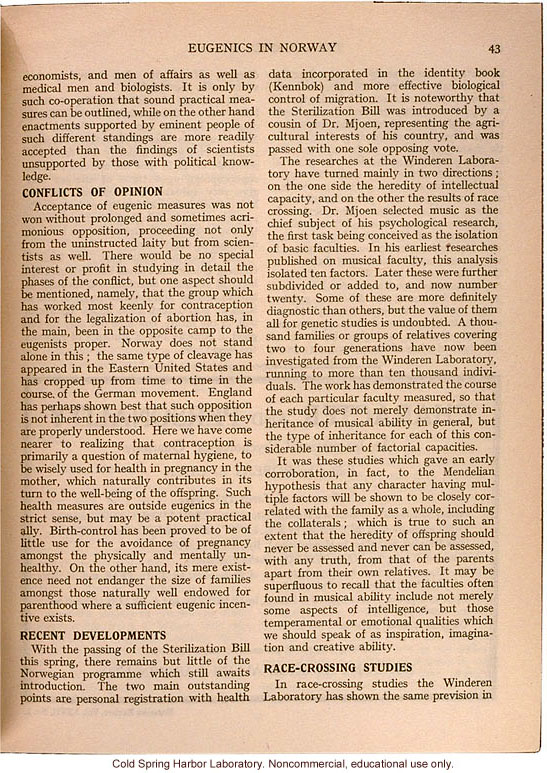Eugenics in Norway 43
economists, and men of affairs as well as medical men and biologists. It is only by such co-operation that sound practical measures can be outlined, while on the other hand enactments supported by eminent people of such different standings are more readily accepted than the findings of scientists unsupported by those with political knowledge.
Conflicts of Opinion
Acceptance of eugenic measures was not won without prolonged and sometimes acrimonious opposition, proceeding not only from the uninstructed laity but from scientists as well. There would be no special interest or profit in studying in detail the phases of the conflict, but one aspect should be mentioned, namely, that the group which has worked most keenly for contraception and for the legalization of abortion has, in the main, been in the opposite camp to the eugenists proper. Norway does not stand alone in this; the same type of cleavage has appeared in the Eastern United States and has cropped up from time to time in the course of the German movement. England has perhaps shown best that such opposition is not inherent in the two positions when they are properly understood. Here we have come nearer to realizing that contraception is primarily a question of maternal hygiene, to be wisely used for health in pregnancy in the mother, which naturally contributes in its turn to the well-being of the offspring. Such health measures are outside eugenics in the strict sense, but may be a potent practical ally. Birth-control has proved to be of little use for the avoidance of pregnancy amongst the physically and mentally unhealthy. On the other hand, its mere existence need not endanger the size of families amongst those naturally well endowed for parenthood where a sufficient eugenic incentive exists.
Recent Developments
With the passing of the Sterilization Bill this spring, there remains but little of the Norwegian programme which still awaits introduction. The two main outstanding points are personal registration with health data incorporated in the identity book (Kennbok) and more effective biological control of migration. It is noteworthy that the Sterilization Bill was introduced by a cousin of Dr. Mjoen, representing the agricultural interests of his country, and was passed with one sole opposing vote.
The researches at Winderen Laboratory have turned mainly in two directions; on the one side the heredity of intellectual capacity, and on the other the results of race crossing. Dr. Mjoen selected music as the chief subject of his psychological research, the first task being conceived as the isolation of basic faculties. In his earliest researches published on musical faculty, this analysis isolated ten factors. Later these were further subdivided or added to, and now number twenty. Some of these are more definitely diagnostic than others, but the value of them all for genetic studies is undoubted. A thousand families or groups of relatives covering two to four generations have now been investigated from the Winderen Laboratory, running to more than ten thousand individuals. The work has demonstrated the course of each particular faculty measured, so that the study does not merely demonstrate inheritance of musical ability in general, but the type of inheritance for each this considerable number of factorial capacities.
It was these studies which gave an early corroboration, in fact, to the Mendelian hypothesis that any character having multiple factors will be shown to be closely correlated to the family as a whole, including the collaterals; which is true to such an extent that the heredity of offspring should never be assessed and never can be assessed, with any truth, from that of the parents apart from their own relatives. It may be superfluous to recall that the faculties often found in musical ability include not merely some aspects of intelligence, but those temperamental or emotional qualities which we should speak of as inspiration, imagination and creative ability.
Race-Crossing Studies
In race-crossing studies the Winderen Laboratory has shown the same prevision in
[end]


